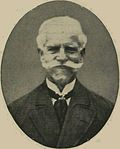Poplar South (UK Parliament constituency)
| South Poplar | |
|---|---|
| Former borough constituency for the House of Commons | |
 Poplar South in the County of London | |
| 1918–1950 | |
| Seats | one |
| Created from | Poplar |
| Replaced by | Poplar |
Poplar South (strictly South Poplar, although this is an unusual form of official name for a borough constituency) was a parliamentary constituency centred on the Poplar district of the East End of London. It returned one Member of Parliament (MP) to the House of Commons of the Parliament of the United Kingdom.
The constituency was created for the 1918 general election, and abolished for the 1950 general election. It was then largely replaced by a new Poplar constituency.
Boundaries

The Borough of Poplar wards of Bromley Central, Bromley South East, Poplar Cubitt Town, Poplar East, Poplar Millwall, Poplar North West, and Poplar West.
Members of Parliament
| Election | Member | Party | |
|---|---|---|---|
| 1918 | Alfred Yeo | Liberal | |
| 1922 | Samuel March | Labour | |
| 1931 | David Adams | Labour | |
| 1942 by-election | William Guy | Labour | |
| 1950 | constituency abolished: see Poplar | ||
Election results
Elections in the 1910s

| Party | Candidate | Votes | % | ±% | |
|---|---|---|---|---|---|
| C | Liberal | Alfred Yeo | 8,571 | 49.4 | |
| Labour | Samuel March | 4,446 | 25.6 | ||
| Unionist | Wilfrid T. Allen | 4,339 | 25.0 | ||
| Majority | 4,125 | 23.8 | |||
| Turnout | 36,077 | 48.1 | |||
| Liberal win (new seat) | |||||
| C indicates candidate endorsed by the coalition government. | |||||
Elections in the 1920s
| Party | Candidate | Votes | % | ±% | |
|---|---|---|---|---|---|
| Labour | Samuel March | 14,484 | 58.8 | +33.2 | |
| National Liberal | Alfred Yeo | 10,146 | 41.2 | New | |
| Majority | 4,338 | 17.6 | N/A | ||
| Turnout | 37,026 | 66.5 | +18.4 | ||
| Labour gain from Liberal | Swing | +20.7 | |||
| Party | Candidate | Votes | % | ±% | |
|---|---|---|---|---|---|
| Labour | Samuel March | 14,537 | 64.8 | +6.0 | |
| Liberal | Harold Heathcote-Williams | 7,899 | 35.2 | −6.0 | |
| Majority | 6,638 | 29.6 | +12.0 | ||
| Turnout | 37,681 | 59.5 | −7.0 | ||
| Labour hold | Swing | +6.0 | |||
| Party | Candidate | Votes | % | ±% | |
|---|---|---|---|---|---|
| Labour | Samuel March | 16,224 | 62.6 | −2.2 | |
| Liberal | Harold Heathcote-Williams | 9,709 | 37.4 | +2.2 | |
| Majority | 6,515 | 25.2 | −4.4 | ||
| Turnout | 38,336 | 67.6 | +8.1 | ||
| Labour hold | Swing | -2.2 | |||
| Party | Candidate | Votes | % | ±% | |
|---|---|---|---|---|---|
| Labour | Samuel March | 19,696 | 64.8 | +2.2 | |
| Liberal | Harold Heathcote-Williams | 7,185 | 23.6 | −13.8 | |
| Unionist | Elliot Marcet Gorst | 3,532 | 11.6 | New | |
| Majority | 12,511 | 41.2 | +16.0 | ||
| Turnout | 47,845 | 63.6 | −4.0 | ||
| Labour hold | Swing | +8.0 | |||
Elections in the 1930s
| Party | Candidate | Votes | % | ±% | |
|---|---|---|---|---|---|
| Labour | David Morgan Adams | 16,253 | 57.6 | −7.2 | |
| Liberal | Herbert Leonard M. Jones | 11,965 | 42.4 | +18.8 | |
| Majority | 4,288 | 15.2 | −26.0 | ||
| Turnout | 48,166 | 58.6 | −5.0 | ||
| Labour hold | Swing | -13.0 | |||
| Party | Candidate | Votes | % | ±% | |
|---|---|---|---|---|---|
| Labour | David Morgan Adams | 18,715 | 73.2 | +15.6 | |
| Conservative | Diana Spearman | 6,862 | 26.8 | New | |
| Majority | 11,853 | 46.4 | +31.2 | ||
| Turnout | 46,231 | 55.3 | −3.3 | ||
| Labour hold | Swing | N/A | |||
Elections in the 1940s
| Party | Candidate | Votes | % | ±% | |
|---|---|---|---|---|---|
| Labour | William Henry Guy | 3,375 | 86.2 | +13.0 | |
| Christian Socialist | P.H. Figgis | 541 | 13.8 | New | |
| Majority | 2,834 | 72.4 | −26.0 | ||
| Turnout | 3,916 | 8.5 | |||
| Labour hold | Swing | N/A | |||
| Party | Candidate | Votes | % | ±% | |
|---|---|---|---|---|---|
| Labour | William Henry Guy | 11,620 | 89.2 | +16.0 | |
| National Liberal | Joan Vickers | 1,403 | 10.8 | −16.0 | |
| Majority | 10,217 | 78.4 | +32.0 | ||
| Turnout | 19,667 | 66.2 | +10.9 | ||
| Labour hold | Swing | N/A | |||
